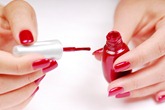Our Personal Environment II: What Gets Under Our Skin
 We don’t only absorb what we eat. The skin that seems to shield us from the world is actually one big sponge, selectively absorbing almost everything with which it comes into contact. Most of us don’t take this into account.
We don’t only absorb what we eat. The skin that seems to shield us from the world is actually one big sponge, selectively absorbing almost everything with which it comes into contact. Most of us don’t take this into account.
Maybe it’s just too much to think about, even though we put a lot of chemicals on our bodies every day. We wash, we shave, we brush our teeth, we wash our hair. We wear clothes, cosmetics, body lotions, deodorants and perfumes. We lather, we rinse, we cream, we dab all kinds of stuff on ourselves with nary a thought about the chemicals we might be inviting to come through our epithelium – which includes not only our skin but also the lining of our mouths, lungs, gut and sex organs. (We will deal with the air we breathe in future articles, when we look at what we need to do for our homes and streets and workplaces.)
Most of these substances do what they say they will do. They clean, shine, soften, deodorize and leave us “with a minty taste.” It’s what else they may do – about which they say nothing – that can be a problem. But since the EPA hasn’t required the companies that use most these chemicals to do any disclosure – not to speak of epidemiological studies – most of the claims about the harm that they can do have almost as little to back them up as the claims that the manufacturers make for their products. There are any number of books and articles that indict almost every ingredient used in these products. Hard data on what most of these ingredients can do in the minute quantities most of them are used is another matter
Even though we don’t yet know which chemical might have which effect, there at least four big problems with the ones we’re exposed to: One is that a number of the chemicals appear to be toxic and there is lots of evidence that several of them are affecting our health and the development of our children, but we don’t exactly know which ones. Two is that when we wash them off and flush them down the drain into our water supplies, they accumulate and affect the purity of our drinking water and the health of our wildlife. Three is that while the amount we may be absorbing from any one product at any one time may indeed be too miniscule to affect us chemically, that may not be the end of it. We won’t know  until some serious studies are done (probably years from now) whether any one of those chemicals is reacting with a minute dose of another chemical we’re absorbing from another product to form a toxic compound that is, in fact, harming us. Four is that the same thing goes for minute amounts of chemicals that are not broken down but stored in our bodies: they bio-accumulate. At what point is there enough of any one of these chemicals for it to do bad things to us? We don’t know.
until some serious studies are done (probably years from now) whether any one of those chemicals is reacting with a minute dose of another chemical we’re absorbing from another product to form a toxic compound that is, in fact, harming us. Four is that the same thing goes for minute amounts of chemicals that are not broken down but stored in our bodies: they bio-accumulate. At what point is there enough of any one of these chemicals for it to do bad things to us? We don’t know.
As long as the EPA delays the investigation of harmful chemicals the way it did during the W. Bush years, and as long as there is relatively little hard data on exactly which chemicals are doing what, we’re stuck with educated guesses about what chemicals to avoid. And the chemical industry and the manufacturers who use these substances are lobbying and spreading misinformation at a great rate. At the same time, few of us are prepared to go back to Mother Nature for what we use on our bodies. We’re not about to crush the roots of a soap plant for to take a bath or use Neem tree twigs to clean our teeth.
So all we can do here as authors is to flag a few of the chemical offenders with substantive track records for some of the items in daily use. Probably the single best thing we can do as individuals is to start to substitute products claiming “natural” or “non-toxic” ingredients for conventional products with a long chemical menu, hoping that at some point the government will find better ways to protect us from chemicals that shouldn’t be in the products we use. Here’s some of the hard information that’s available.
Toothpaste: Chemical as it may taste, no particular item in the typical list of ingredients for toothpaste stands out, although some may be  surprised to find that their toothpaste contains sugar to make it taste sweet. Even titanium dioxide, which is used to make white toothpaste white and pasty, appears only to have proven carcinogenic properties when it is inhaled as dust.
surprised to find that their toothpaste contains sugar to make it taste sweet. Even titanium dioxide, which is used to make white toothpaste white and pasty, appears only to have proven carcinogenic properties when it is inhaled as dust.
Shaving Cream: A wetting agent frequently used in shaving creams to make them lather more richly is diethanolamine (DEA). The National Toxicology Program (NTP), run by the National Institute of Health (NIH), said that while studies only showed that it could cause kidney and liver cancer in mice, “DEA is readily absorbed through the skin and accumulates in organs, such as the brain, where it induces chronic toxic effects.” It looks like DEA might be worth avoiding.
Bath Soap: The chemicals most often quoted as being of concern in body soaps and many other products we use are the anti-bacterials, especially triclosan. The main concern is that this and other anti-bacterials are contributing to the development of bacterial strains resistant to antibiotics, not only when they are absorbed through the skin but as they escape filtration and reappear in increasing quantities in our drinking water. It also appears that they may act as endocrine disruptors. If you’re not doing surgery or some other job requiring exceptional cleanliness, non-bacterial soaps will remove bacteria from the skin just as well as soaps containing anti-bacterial compounds, so this is an easily avoidable risk.
Shampoos & Conditioners: Aside from DEA in shampoos and conditioners, an ingredient that has been called out in a number of publications is methylisothiazoline, a preservative that has been linked to nerve damage in an experiment with rats. However, the European committee that rules on chemicals in cosmetics said that in the concentration that it is used, like one ppm, it’s safe. Considering that the Europeans have flagged some 1100 substances in consumer products while our EPA has less than 20 on its list, we can hope that the European judgment on methylisothiazoline can be relied on.
 Deodorants & Antiperspirants: The principal ingredients that make these products effective are aluminum compounds, typically aluminium zirconium tetrachlorohydrex gly. They work by reacting with the electrolytes in sweat to form a plug in the duct of the sweat gland to stop the gland from excreting. A gathering body of evidence indicates that the accumulation of these compounds in the tissues over time may be contributing to such different diseases as breast cancer and Alzheimer’s. This accumulation has cause the FDA to warn people with kidney problems that the use of aluminum-based products put them at higher risk. Maybe the rest of us should take note as well.
Deodorants & Antiperspirants: The principal ingredients that make these products effective are aluminum compounds, typically aluminium zirconium tetrachlorohydrex gly. They work by reacting with the electrolytes in sweat to form a plug in the duct of the sweat gland to stop the gland from excreting. A gathering body of evidence indicates that the accumulation of these compounds in the tissues over time may be contributing to such different diseases as breast cancer and Alzheimer’s. This accumulation has cause the FDA to warn people with kidney problems that the use of aluminum-based products put them at higher risk. Maybe the rest of us should take note as well.
Creams and Lotions: A chemical that appears in many of these products as well as an enormous range of household, medical and industrial materials is Tetrasodium EDTA, one of the most common forms of EDTA, or ethylenediaminetetracetic acid. In testing at the concentrations normally used, it shows low toxicity, but as it is accumulated in tissues over time to form larger doses, it can damage cells. However, it still has full approval of the EPA, and several forms of EDTA are even used as injectibles for medical purposes. But aside from its potential for toxicity, its widespread use in so many products has made it a persistent organic pollutant (POP) – one of the most widespread anthropogenic (human-made) substances polluting inland waters.
Clothing: The substances in our clothing can be put there during manufacture or when we wash and clean the clothes we wear. The principal concern that we may be wearing the modern equivalent of the mythical poison cloak that the sorceress tries to drape on the hero comes from the widespread use of brominated flame retardants (BFR) and polybrominated diphenyl ether (PBDE) Flame retardants have been required in clothing since the sixties, when it was found that the early synthetic fabrics were dangerously flammable. But to accomplish this, we seem to have traded a certain danger for a more long-term disaster. Both BFR’s and PBDE’s are hormone disruptors that affect children’s sexual development, especially boys’, and can damage the liver and thyroid. These chemicals are also used in clothes made of natural fibers and are not identified on clothing labels, which is part of the problem.
Nail Polishes and Removers: The smell of nail polishes tells us they are toxic, but once they are dry, they don’t seem to be doing any harm,  and that appears to be true. However, there is no question that nail polishes contain volatile organic compounds (VOC’s) that should not be inhaled in any quantity. One of these VOC’s, dibutyl phthalate (DBP), is associated with both obesity and hormone disruption, both in males, has been banned by the EU, and has been gradually removed from most major brands of nail polish.
and that appears to be true. However, there is no question that nail polishes contain volatile organic compounds (VOC’s) that should not be inhaled in any quantity. One of these VOC’s, dibutyl phthalate (DBP), is associated with both obesity and hormone disruption, both in males, has been banned by the EU, and has been gradually removed from most major brands of nail polish.
Still, the basic problem remains: if you follow the lists of ingredients labeled toxic by environmental sites to scientific papers about them, it’s hard to find strong scientific backup for many of the claims. For example, the acetone that is the main functioning ingredient of nail polish can be very dangerous if inhaled in large amounts or ingested, but there aren’t any studies of how the amount inhaled while removing nail polish will have any toxic affect on the average person. Again, there are individual differences in individual sensitivities, so some individuals will have greater reactions than the majority. Again, the issue is complicated by the problem that we haven’t studied – whether combined exposures may have toxic effects that single exposures do not.
Perfumes and Fragrances: Dozens of chemicals are used to make a perfume. Perfumes compounded earlier in the 20th Century, like Shalimar and Chanel No. 5, were mainly a concoction of flower essences. However, contemporary perfumes and fragrances, including fragrances used as additives to many of the products listed here, contain a number of synthetic chemicals which appear to be extremely toxic when used full strength.
In the minute amounts in which they are used in perfumes and fragrances, however, scientifically established cases for toxicity are hard to find. For example, a common fragrance ingredient, limonene, is listed by many sites as highly toxic. However, when you read the studies, that’s not true. The WHO’s International Agency for Research on Cancer (IARC) has concluded that, “once thought to cause renal cancer in rats, limonene now is considered by some researchers to be a significant chemo-preventive agent with potential value as a dietary anti-cancer tool in humans.“
Nevertheless, it is also true that many individuals have asthmatic and skin reactions to these fragrances. So until we know a lot more, we need to weigh whether the presence of “fragrance” in a list of ingredients is worth the risk.


